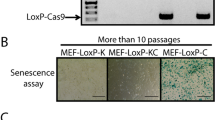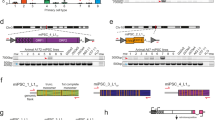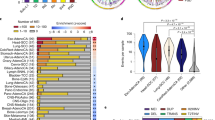Abstract
Creating spontaneous yet genetically tractable human tumors from normal cells presents a fundamental challenge. Here we combined retroviral and transposon insertional mutagenesis to enable cancer gene discovery starting with human primary cells. We used lentiviruses to seed gain- and loss-of-function gene disruption elements, which were further deployed by Sleeping Beauty transposons throughout the genome of human bone explant mesenchymal cells. De novo tumors generated rapidly in this context were high-grade myxofibrosarcomas. Tumor insertion sites were enriched in recurrent somatic copy-number aberration regions from multiple cancer types and could be used to pinpoint new driver genes that sustain somatic alterations in patients. We identified HDLBP, which encodes the RNA-binding protein vigilin, as a candidate tumor suppressor deleted at 2q37.3 in greater than one out of ten tumors across multiple tissues of origin. Hybrid viral-transposon systems may accelerate the functional annotation of cancer genomes by enabling insertional mutagenesis screens in higher eukaryotes that are not amenable to germline transgenesis.
This is a preview of subscription content, access via your institution
Access options
Subscribe to this journal
Receive 12 print issues and online access
$209.00 per year
only $17.42 per issue
Buy this article
- Purchase on Springer Link
- Instant access to full article PDF
Prices may be subject to local taxes which are calculated during checkout






Similar content being viewed by others
Accession codes
Change history
16 October 2014
In the version of this article initially published, the name of author Zsuzsanna Izsvák was misspelled. The error has been corrected in the HTML and PDF versions of the article.
References
Uren, A.G. et al. Large-scale mutagenesis in p19ARF- and p53-deficient mice identifies cancer genes and their collaborative networks. Cell 133, 727–741 (2008).
Collier, L.S. et al. Cancer gene discovery in solid tumors using transposon-based somatic mutagenesis in the mouse. Nature 436, 272–276 (2005).
Mikkers, H. & Berns, A. Retroviral insertional mutagenesis: tagging cancer pathways. Adv. Cancer Res. 88, 53–99 (2003).
Ivics, Z. et al. Molecular reconstruction of Sleeping Beauty, a Tc1-like transposon from fish, and its transposition in human cells. Cell 91, 501–510 (1997).
Dupuy, A.J. et al. Mammalian mutagenesis using a highly mobile somatic Sleeping Beauty transposon system. Nature 436, 221–226 (2005).
Keng, V.W. et al. A conditional transposon-based insertional mutagenesis screen for genes associated with mouse hepatocellular carcinoma. Nat. Biotechnol. 27, 264–274 (2009).
Rad, R. et al. PiggyBac transposon mutagenesis: a tool for cancer gene discovery in mice. Science 330, 1104–1107 (2010).
Berquam-Vrieze, K.E. et al. Cell of origin strongly influences genetic selection in mouse models of T-ALL. Blood 118, 4646–4656 (2011).
Fudenberg, G. et al. High order chromatin architecture shapes the landscape of chromosomal alterations in cancer. Nat. Biotechnol. 29, 1109–1113 (2011).
De, S. & Michor, F. DNA replication timing and long-range DNA interactions predict mutational landscapes of cancer genomes. Nat. Biotechnol. 29, 1103–1108 (2011).
Moffat, J. et al. A lentiviral RNAi library for human and mouse genes applied to an arrayed viral high-content screen. Cell 124, 1283–1298 (2006).
Ivics, Z. et al. Transposon-mediated genome manipulation in vertebrates. Nat. Methods 6, 415–422 (2009).
Mátés, L. et al. Molecular evolution of a novel hyperactive Sleeping Beauty transposase enables robust stable gene transfer in vertebrates. Nat. Genet. 41, 753–761 (2009).
Szulc, J. et al. A versatile tool for conditional gene expression and knockdown. Nat. Methods 3, 109–116 (2006).
Staunstrup, N.H. et al. Hybrid lentivirus-transposon vectors with a random integration profile in human cells. Mol. Ther. 17, 1205–1214 (2009).
Vink, C.A. et al. Sleeping Beauty transposition from nonintegrating lentivirus. Mol. Ther. 17, 1197–1204 (2009).
Hahn, W.C. et al. Creation of human tumour cells with defined genetic elements. Nature 400, 464–468 (1999).
Boehm, J.S. et al. Transformation of human and murine fibroblasts without viral oncoproteins. Mol. Cell. Biol. 25, 6464–6474 (2005).
Mentzel, T. & van den Berg, E.M.W. in Pathology & Genetics: Tumours of Soft Tissue and Bone 102–103 (IARC Press, Lyon, France, 2002).
Schmidt, M. et al. High-resolution insertion-site analysis by linear amplification-mediated PCR (LAM-PCR). Nat. Methods 4, 1051–1057 (2007).
Moldt, B. et al. Comparative genomic integration profiling of Sleeping Beauty transposons mobilized with high efficacy from integrase-defective lentiviral vectors in primary human cells. Mol. Ther. 19, 1499–1510 (2011).
Sandve, G.K. et al. The Genomic HyperBrowser: inferential genomics at the sequence level. Genome Biol. 11, R121 (2010).
Beroukhim, R. et al. The landscape of somatic copy-number alteration across human cancers. Nature 463, 899–905 (2010).
Barretina, J. et al. Subtype-specific genomic alterations define new targets for soft-tissue sarcoma therapy. Nat. Genet. 42, 715–721 (2010).
Yu, X. et al. Chfr is required for tumor suppression and Aurora A regulation. Nat. Genet. 37, 401–406 (2005).
Scolnick, D.M. & Halazonetis, T.D. Chfr defines a mitotic stress checkpoint that delays entry into metaphase. Nature 406, 430–435 (2000).
Yajnik, V. et al. DOCK4, a GTPase activator, is disrupted during tumorigenesis. Cell 112, 673–684 (2003).
Kuramochi, M. et al. TSLC1 is a tumor-suppressor gene in human non–small-cell lung cancer. Nat. Genet. 27, 427–430 (2001).
Murakami, Y. Involvement of a cell adhesion molecule, TSLC1/IGSF4, in human oncogenesis. Cancer Sci. 96, 543–552 (2005).
Bric, A. et al. Functional identification of tumor-suppressor genes through an in vivo RNA interference screen in a mouse lymphoma model. Cancer Cell 16, 324–335 (2009).
Solomon, D.A. et al. Mutational inactivation of STAG2 causes aneuploidy in human cancer. Science 333, 1039–1043 (2011).
Bamford, S. et al. The COSMIC (Catalogue of Somatic Mutations in Cancer) database and website. Br. J. Cancer 91, 355–358 (2004).
Sjöblom, T. et al. The consensus coding sequences of human breast and colorectal cancers. Science 314, 268–274 (2006).
Wei, X. et al. Exome sequencing identifies GRIN2A as frequently mutated in melanoma. Nat. Genet. 43, 442–446 (2011).
Jones, S. et al. Core signaling pathways in human pancreatic cancers revealed by global genomic analyses. Science 321, 1801–1806 (2008).
Dalgliesh, G.L. et al. Systematic sequencing of renal carcinoma reveals inactivation of histone modifying genes. Nature 463, 360–363 (2010).
Hudson, T.J. & Anderson, W. International network of cancer genome projects. Nature 464, 993–998 (2010).
Huh, K.-W. et al. Association of the human papillomavirus type 16 E7 oncoprotein with the 600-kDa retinoblastoma protein–associated factor, p600. Proc. Natl. Acad. Sci. USA 102, 11492–11497 (2005).
Hernández, P. et al. Integrative analysis of a cancer somatic mutome. Mol. Cancer 6, 13 (2007).
Barretina, J. et al. The Cancer Cell Line Encyclopedia enables predictive modelling of anticancer drug sensitivity. Nature 483, 603–607 (2012).
Woo, H.-H. et al. Posttranscriptional suppression of proto-oncogene c-fms expression by vigilin in breast cancer. Mol. Cell. Biol. 31, 215–225 (2011).
Zhou, J. et al. On the mechanism of induction of heterochromatin by the RNA-binding protein vigilin. RNA 14, 1773–1781 (2008).
Fernandez, H.R. et al. Heterochromatin: on the ADAR radar? Curr. Biol. 15, R132–R134 (2005).
Paz, N. et al. Altered adenosine-to-inosine RNA editing in human cancer. Genome Res. 17, 1586–1595 (2007).
Wang, Q. et al. Vigilins bind to promiscuously A-to-I–edited RNAs and are involved in the formation of heterochromatin. Curr. Biol. 15, 384–391 (2005).
Yen, C.-C. et al. Identification of chromosomal aberrations associated with disease progression and a novel 3q13.31 deletion involving LSAMP gene in osteosarcoma. Int. J. Oncol. 35, 775–788 (2009).
Beroukhim, R. et al. Assessing the significance of chromosomal aberrations in cancer: methodology and application to glioma. Proc. Natl. Acad. Sci. USA 104, 20007–20012 (2007).
Acknowledgements
S.D.M. was supported by the Canadian Institutes of Health Research (CIHR) Banting and Best Doctoral Research Award. This project was supported by Ontario Institute for Cancer Research (OICR; grant 09NOV-328) and Canadian Cancer Society Research Institute (CCSRI; grant 2012 701468) grants to R.K. We thank D. Largaespada (University of Minnesota) and Z. Izsvak (Max Delbruck Center) for providing materials related to the Sleeping Beauty transposon, J. Moffat (Donnelly Center) for providing lentiviral vectors, C. Miskey (Max Delbruck Center) for discussions related to LAM-PCR and K. Munger (Harvard Medical School) for providing the UBR4 knockdown vector. We also thank all core facility services involved in this work, especially L. Lau at The Centre for Applied Genomics, J. Pittman for electron microscopy and G. Kuruzar for immunohistochemistry. We also thank M. Di Grappa for facilitating artwork.
Author information
Authors and Affiliations
Contributions
S.D.M. conceptualized the project, performed experiments and bioinformatics, developed the vectors, designed the experiments and wrote the manuscript. P.D.W. helped design experiments and assisted with vector construction and manuscript preparation. I.S.H., working with T.W.M., performed FACS analysis and assisted with experimental design. C.M.W. assisted with cell culture and PCR analyses. G.K.S. developed hyperbrowser modules. Y.W.S. facilitated bioinformatics. B.C.D. undertook histopathology analyses. J.S.W. provided surgical samples. M.L., X.Z. and S.D.B. performed and analyzed FAIRE-Seq. D.S. performed ddPCR. Q.-L.T. performed colony-forming assays. H.B. provided human epithelial cells, on which P.T. performed SB transposition experiments. Z.I. provided the hyperactive Sleeping Beauty construct. R.K. coordinated the project and wrote the manuscript.
Corresponding author
Ethics declarations
Competing interests
The authors declare no competing financial interests.
Integrated supplementary information
Supplementary Figure 1 Lentihop LV transduction and inducible SB transposition in human cells.
a-b, Detection of genomically integrated Lentihop vectors and transposition events in 293T cells (Pf/r, forward/reverse transposition assay primers; Tn-int, SB transposon internal primers; 293-SB, 293T cells transduced for SB100x expression; 293-SB-LH, 293-SB cells transduced with Lentihop-L vector; 293-SB/Tet, 293T cells co-transduced for SB100x and tTR-KRAB expression; 293-SB/Tet-LH, 293-SB/Tet cells transduced with Lentihop-L vector; Dox+, cells cultured in media supplemented with 100ng doxycycline for 10 days). Pf/r reaction detects proviral resident SB (1851 bp) and SB mobilized (202 bp) bands (see Fig. 1b). Single primer Pf or Pr reactions were used to examine the possibility of cross-priming from genomically adjacent integrated Lentihop vectors in opposite orientations (Pf and Pr reaction bands produced in vector control lanes (2-3) represent dominant false-priming products from bacterial plasmid sequences not present after virus production). Tn-int reaction (726bp band) detects the presence of SB transposons independently of their associated LV vector, verifying the maintenance of SB in the genome following transposition from within proviruses.
Supplementary Figure 2 Normal bone explant cultures and Ras-induced tumorigenesis in sensitized genetic contexts.
a, Explant cultures grown from cleaned bone fragments of patients undergoing hip and knee replacement surgery. Primary cells can be seen to be growing out of the trabecular bone fragments placed in culture. b, Mice injected with 5x105 T5R, T5RM, T5R-Ras, or T5RM-Ras control cells, examined for tumors at 4.3 weeks (6 flanks/3 mice each; white arrows identify tumors).c, H&E stained sections of undifferentiated mesenchymal tumors obtained from T5RM-Ras cell injected mice. Scale bars: 200 μm (left), 50 μm (right).
Supplementary Figure 3 Additional histopathologic attributes of the induced sarcomas.
a, Representative mice bearing tumors grown from Lentihop infected sensitized cells. Mice were subcutaneously inoculated in each flank with 5X105 T5RM-SB-LH (n=31 flanks/16 mice) or T5RM-SB control cells (n=6 flanks/3 mice); were harvested for tumors at 4 weeks (white arrows indicate tumors). Also see Fig. 2b for flow chart of the genetic screen tumorigenesis assays. b, Hypercellular area of tumor lacking myxoid stroma, and exhibiting an epithelioid cytology (top left). Spontaneous tumor necrosis (H&E; top right). c, Immunohistochemistry confirming a lack of staining for desmin (note: skeletal muscle internal positive control; haematoxylin counter stain). Scale bars: 200 μm.
Supplementary Figure 4 Genomically integrated Lentihop vectors and transposition events in induced sarcomas.
a, Genomic PCR detects Lentihop LV vectors (SB in provirus) and transposition events (SB mobilized) in tumors (Pf/r transposition assay reaction, upper gel). The presence of SB transposon elements were independently verified (Lentihop-G or -L primer reactions, middle two gels). RPPH1 provides a human genomic endogenous control (bottom gel).
Supplementary Figure 5 Validation of endogenous copy number reference loci on human reference DNA and the tumor panel.
a, Copy number measurements using ddPCR on genomic DNA from a female human lymphoblast cell line (Coriell #19108) demonstrates precise resolution of discrete copy number states for a panel of endogenous loci. The first 5 bars represent data normalized to RPP30 (indicated on bottom row of x-axis legend). The last three bars compare the copy number states for ERBB2 produced by substituting RPP30 for ch10p3 or Fan_ch1 as a reference. b, Correlation of MRGPRX1 and RPP30 copy number variation (R Pearson=0.760) and c, concentrations across the tumor samples (R Pearson=0.989).
Supplementary Figure 6 Analysis of FAIRE regions with gene expression and Lentihop insertions.
a, Examples of genomic regions in which the SB and LV insertions reside, integrated with chromatin state data. Expression data is presented as a heatmap (n=12 tumors, 3 controls; red, high; blue, low). The FAIRE-seq signal (line graph) and the FAIRE-positive regions (red bars) generated from the sensitized pre-injection T5RM-SB cells are shown, indicating open chromatin regions within the window. Red boxes indicate chromosomal regions that are zoomed successively.
Supplementary Figure 7 Recurrent amplification of GAB2 across cancers.
a, GAB2 and 14 other genes reside in a high significance (q=3.31x10-18) recurrent cross-cancer SCNA on the q-arm of chromosome 11 (q14.1), as identified by GISTIC analysis. This peak is distinct from CCND1 amplifications at 11q13.3.
Supplementary Figure 8 HDLBP resides within a recurrent deletion peak in diverse cancers subtypes and across cancers.
a, HDLBP is resident within high significance recurrent SCNA deletion peaks in multiple tumor panels including cross-cancer, cross-epithelial and breast cancer. Deletion peaks are indicated by red asterisks, accompanied by GISTIC q-values for each peak. b, GISTIC analysis of human osteosarcoma tumor copy number data shows HDLBP to reside within a significantly recurrent deletion (q=0.02) at 2q37.3 in this sarcoma type.
Supplementary information
Supplementary Text and Figures
Supplementary Figures 1–8, Supplementary Tables 1, 2, 4–6 and 8–16 and Supplementary Note (PDF 6497 kb)
Supplementary Table 3
SB and LV insertions derived from the human cell mutagenesis screen. (XLSX 270 kb)
Supplementary Table 7
All identified common insertion genes integrated with recurrent SCNA and somatic mutation data from patients. (XLS 39 kb)
Source data
Rights and permissions
About this article
Cite this article
Molyneux, S., Waterhouse, P., Shelton, D. et al. Human somatic cell mutagenesis creates genetically tractable sarcomas. Nat Genet 46, 964–972 (2014). https://doi.org/10.1038/ng.3065
Received:
Accepted:
Published:
Issue Date:
DOI: https://doi.org/10.1038/ng.3065
This article is cited by
-
Modulating signaling networks by CRISPR/Cas9-mediated transposable element insertion
Current Genetics (2018)
-
Robust gene expression changes in the ganglia following subclinical reactivation in rhesus macaques infected with simian varicella virus
Journal of NeuroVirology (2017)
-
The RNA-binding protein vigilin regulates VLDL secretion through modulation of Apob mRNA translation
Nature Communications (2016)
-
The utility of transposon mutagenesis for cancer studies in the era of genome editing
Genome Biology (2015)
-
Erratum: Corrigendum: Human somatic cell mutagenesis creates genetically tractable sarcomas
Nature Genetics (2014)



